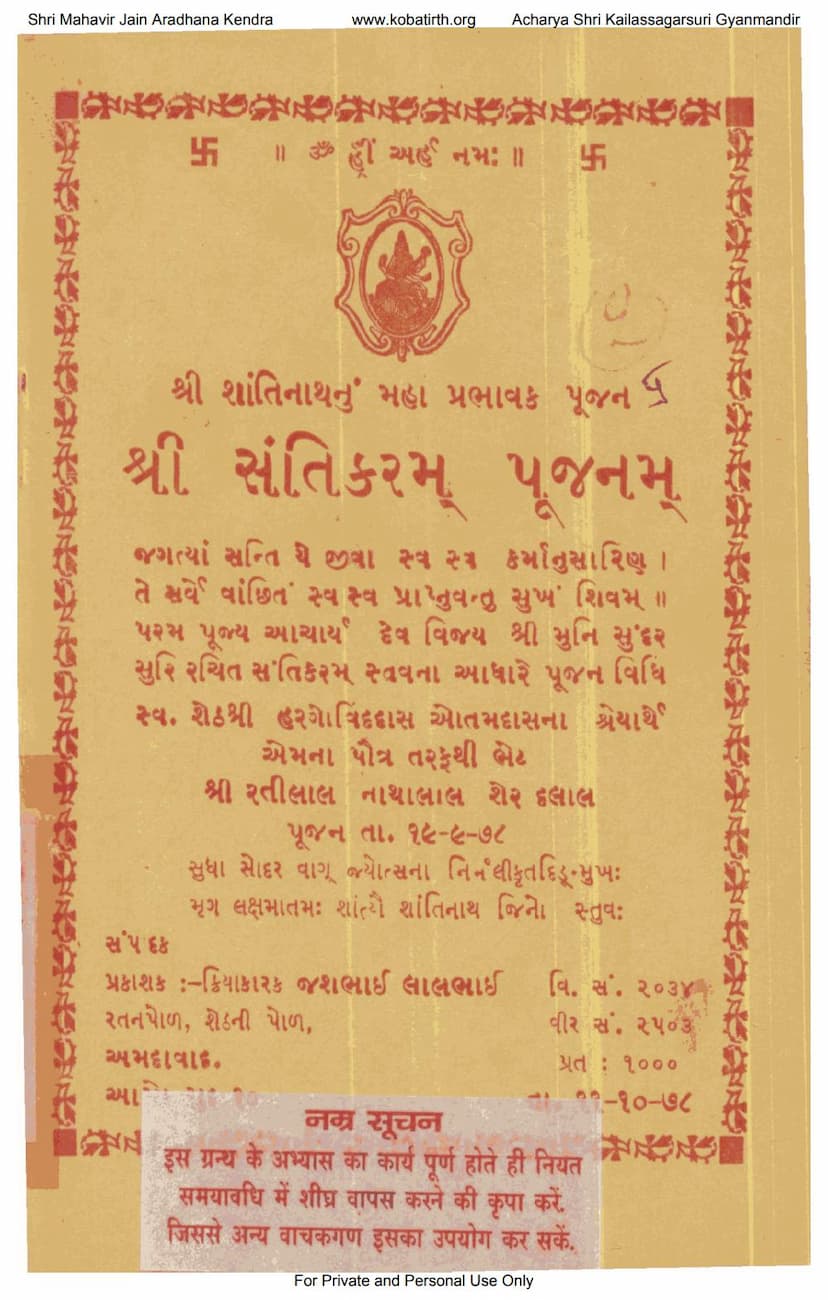Santikaram Pujanam
Added to library: September 2, 2025

Summary
This document is a Jain text titled "Santikaram Pujanam" (Peaceful Worship), authored by Ratilal Nathalal and published by Jashbhai Lalbhai. It is a guide for performing a specific worship ritual dedicated to Bhagwan Shantinath, the 16th Jain Tirthankar.
Here's a comprehensive summary of its content:
1. Introduction and Dedication:
- The book is presented as a "Shri Shantinath Mahaprabhavak Pujanam" (Highly Influential Worship of Lord Shantinath).
- It is compiled based on the "Santikaram Stava" by Param Pujya Acharya Dev Vijay Shri Munisundersuri.
- The publication is a tribute by the grandson, Shri Ratilal Nathalal Sherdalal, to his late grandfather, Seth Shri Hargovinddas Tamdas, a prominent and devout Jain from Ahmedabad. Seth Hargovinddas is described as a learned and virtuous man who dedicated his life to spiritual study and practice.
2. The Significance of Lord Shantinath and the Pujanam:
- Lord Shantinath is described as the remover of the world's sins, the 16th Tirthankar, and the 5th Chakravarti (universal emperor).
- He is invoked for peace and the destruction of ignorance.
- The text emphasizes that the purpose of such pujas is to illuminate "Samyaktva" (right faith/perception) and to help souls break free from karma.
3. The Pujanam Ritual:
- The book details the "Santikaram Pujanam Vidhi" (Method of Peaceful Worship).
- It involves the recitation of specific stotras (hymns) and mantras.
- The worship includes paying homage to various divine beings associated with Lord Shantinath and the Jain tradition, such as:
- Lord Shantinath: The central deity.
- Garuda Yaksha and Nirvani Yakshini: His attendant deities.
- Kshetrapal: The guardian deity of the land.
- Goddess Saraswati: The deity of knowledge and wisdom.
- Goddess Lakshmi: The deity of wealth and prosperity.
- Tribhuvanswami: The lord of the three worlds.
- Ganipitak: The repository of Jain scriptures.
- Navagraha (Nine Planets): Deities influencing celestial bodies.
- Das Dikpal (Ten Guardians of Directions): Important directional deities.
- Sola Vidyadevi (Sixteen Knowledge Goddesses): Deities associated with specific knowledge and powers.
- Various Yaksas and Yakshinis: A vast array of celestial beings.
- Chaturnikaya Devata: Deities from the four classes of celestial beings.
- Guru Paduka: Reverence to the spiritual lineage and gurus.
- Nava Nidhi (Nine Treasures) and Ashta Mahasiddhis (Eight Great Powers): Attainments of spiritual perfection.
4. Structure and Content of the Pujanam:
- The text provides a detailed step-by-step guide for the puja, including:
- Prarthana (Prayer): Invoking the Panch Parameshtis (Supreme Beings).
- Santikaram Stotra Recitation: Singing hymns dedicated to Lord Shantinath.
- Mantra Japa: Chanting specific mantras for spiritual attainment and protection.
- Bhoomi Shuddhi (Purification of the Ground): Rituals to cleanse the worship space.
- Vajrapanjar Stotra: A protective hymn.
- Kshetrapal Puja: Worship of the guardian deity.
- Prabhu Sthapan (Installation of the Deity): Invoking and establishing the divine presence.
- Kusumanjali (Offering of Flowers): Devotional offering.
- Avahan (Invocation): Calling upon the deities.
- Pujans of various deities: Detailed invocations and offerings to Saraswati, Lakshmi, Yaksas, Yakshinis, Vidyadevis, Dikpalas, Navagrahas, Nidhi, and Siddhis.
- Ashta Prakari Puja (Eight Types of Offerings): A common Jain worship practice.
- Aarti and Mangal Deep: Waving lamps as an act of devotion.
- Shanti Kalash: A ritualistic pot for peace.
- Visarjan (Concluding Ritual): Bidding farewell to the deities.
5. Mantras and Their Significance:
- The text highlights specific mantras and their benefits, such as the destruction of obstacles and sins.
- It explains how chanting certain mantras can lead to specific Siddhis (powers) and knowledge.
- The "Suri Mantra" is mentioned as being central to the ritual.
6. Detailed Instructions and Item Lists:
- The book includes a comprehensive list of items required for the puja, categorized as "Pujan ka Saman" (Worship Items) and "Phalon ki Yadi" (List of Fruits). This demonstrates the meticulous nature of the ritual.
- It also provides guidance on preparing the worship space, arranging the "mandala" (sacred diagram), and managing the logistics of the puja.
7. Explanations of the Stotras and Mantras:
- Many of the stotras and mantras are accompanied by explanations of their meaning and purpose, making the ritual accessible and understandable to the devotees.
- The origin and composition of the "Santikaram Stava" by Acharya Munisundersuri are also discussed.
8. Spiritual and Philosophical Context:
- The text emphasizes the importance of Dharma (righteousness) in life, the need for inner purity, and the detachment from material desires.
- It speaks about the nature of devotion, the path to salvation, and the power of good deeds.
9. The Role of the Publishers and Supporters:
- The book acknowledges the contributions of various individuals and organizations in its publication, including the Shri Mahavir Jain Aradhana Kendra, Acharya Shri Kailassagarsuri Gyanmandir, and the individuals who supported the endeavor.
In essence, "Santikaram Pujanam" is a detailed and devotional guide to performing a Jain worship ceremony for Bhagwan Shantinath. It combines sacred hymns, powerful mantras, and meticulous ritualistic procedures to invoke peace, prosperity, and spiritual well-being. The text also serves as a tribute to a respected spiritual personality and highlights the importance of devotion and adherence to Jain principles.